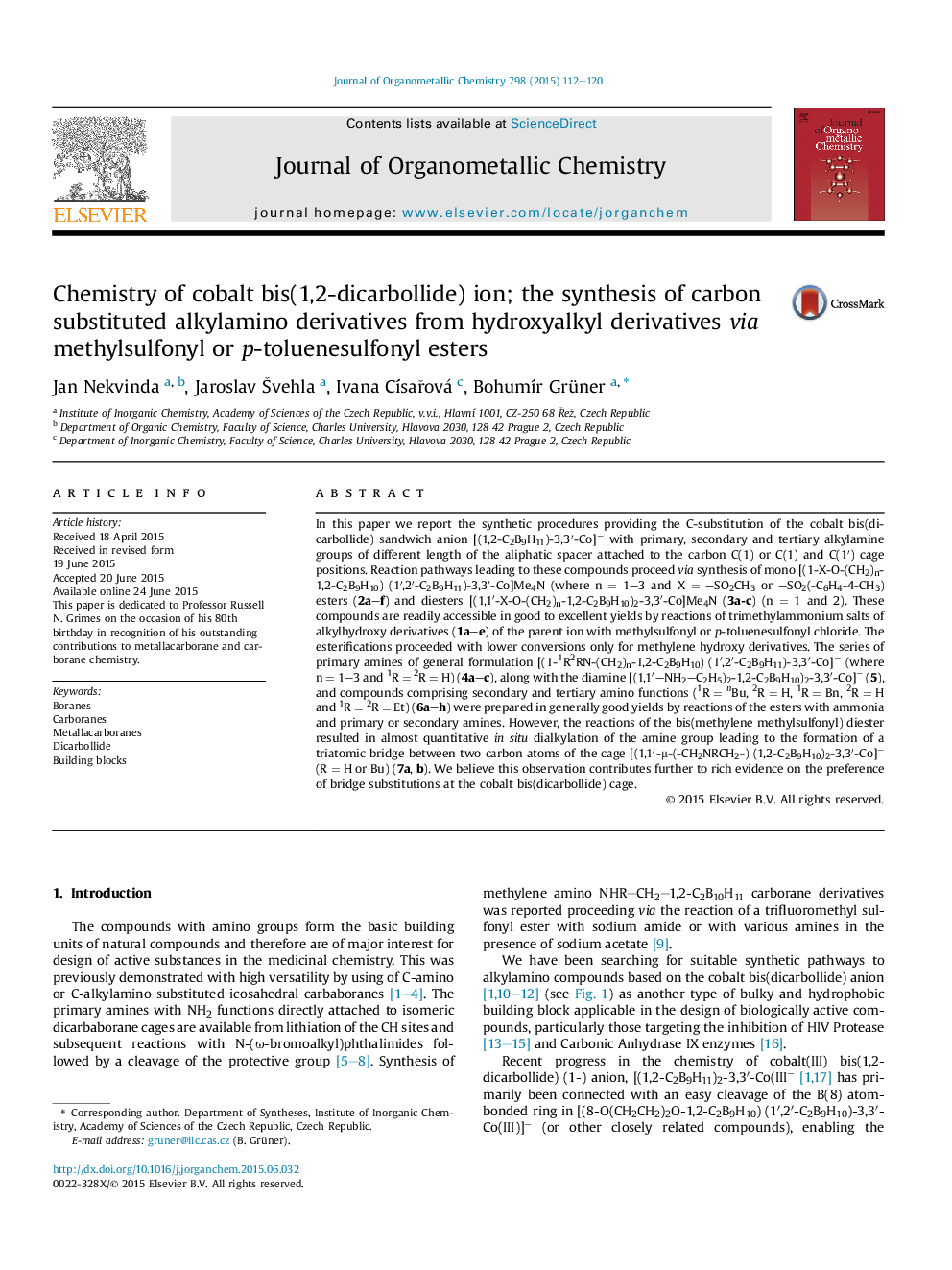| کد مقاله | کد نشریه | سال انتشار | مقاله انگلیسی | نسخه تمام متن |
|---|---|---|---|---|
| 1323270 | 977276 | 2015 | 9 صفحه PDF | دانلود رایگان |

• High yield synthesis of mesyl and tosyl esters and diesters of cobalt bis(dicarbllide) (1-) ion.
• X-ray structures of new esters.
• Their easy conversions to primary, secondary and tertiary amino groups at carbon atoms of the cage.
• Unexpected in situ formation of a triatomic bridge observed for reactions of diesters groups connected via methylene linker.
In this paper we report the synthetic procedures providing the C-substitution of the cobalt bis(dicarbollide) sandwich anion [(1,2-C2B9H11)-3,3′-Co]− with primary, secondary and tertiary alkylamine groups of different length of the aliphatic spacer attached to the carbon C(1) or C(1) and C(1′) cage positions. Reaction pathways leading to these compounds proceed via synthesis of mono [(1-X-O-(CH2)n-1,2-C2B9H10) (1′,2′-C2B9H11)-3,3′-Co]Me4N (where n = 1–3 and X = –SO2CH3 or –SO2(-C6H4-4-CH3) esters (2a–f) and diesters [(1,1′-X-O-(CH2)n-1,2-C2B9H10)2-3,3′-Co]Me4N (3a-c) (n = 1 and 2). These compounds are readily accessible in good to excellent yields by reactions of trimethylammonium salts of alkylhydroxy derivatives (1a–e) of the parent ion with methylsulfonyl or p-toluenesulfonyl chloride. The esterifications proceeded with lower conversions only for methylene hydroxy derivatives. The series of primary amines of general formulation [(1-1R2RN-(CH2)n-1,2-C2B9H10) (1′,2′-C2B9H11)-3,3′-Co]− (where n = 1–3 and 1R = 2R = H) (4a–c), along with the diamine [(1,1′–NH2–C2H5)2-1,2-C2B9H10)2-3,3′-Co]− (5), and compounds comprising secondary and tertiary amino functions (1R = nBu, 2R = H, 1R = Bn, 2R = H and 1R = 2R = Et) (6a–h) were prepared in generally good yields by reactions of the esters with ammonia and primary or secondary amines. However, the reactions of the bis(methylene methylsulfonyl) diester resulted in almost quantitative in situ dialkylation of the amine group leading to the formation of a triatomic bridge between two carbon atoms of the cage [(1,1′-μ-(-CH2NRCH2-) (1,2-C2B9H10)2-3,3′-Co]− (R = H or Bu) (7a, b). We believe this observation contributes further to rich evidence on the preference of bridge substitutions at the cobalt bis(dicarbollide) cage.
Reactions pathways for modification of cobalt bis(dicarbollide) (1-) ion with tosyl and mesyl ester groups at carbon atoms and their further conversions to various amino functions are described enabling direct and versatile ways for cage modifications.Figure optionsDownload as PowerPoint slide
Journal: Journal of Organometallic Chemistry - Volume 798, Part 1, 1 December 2015, Pages 112–120